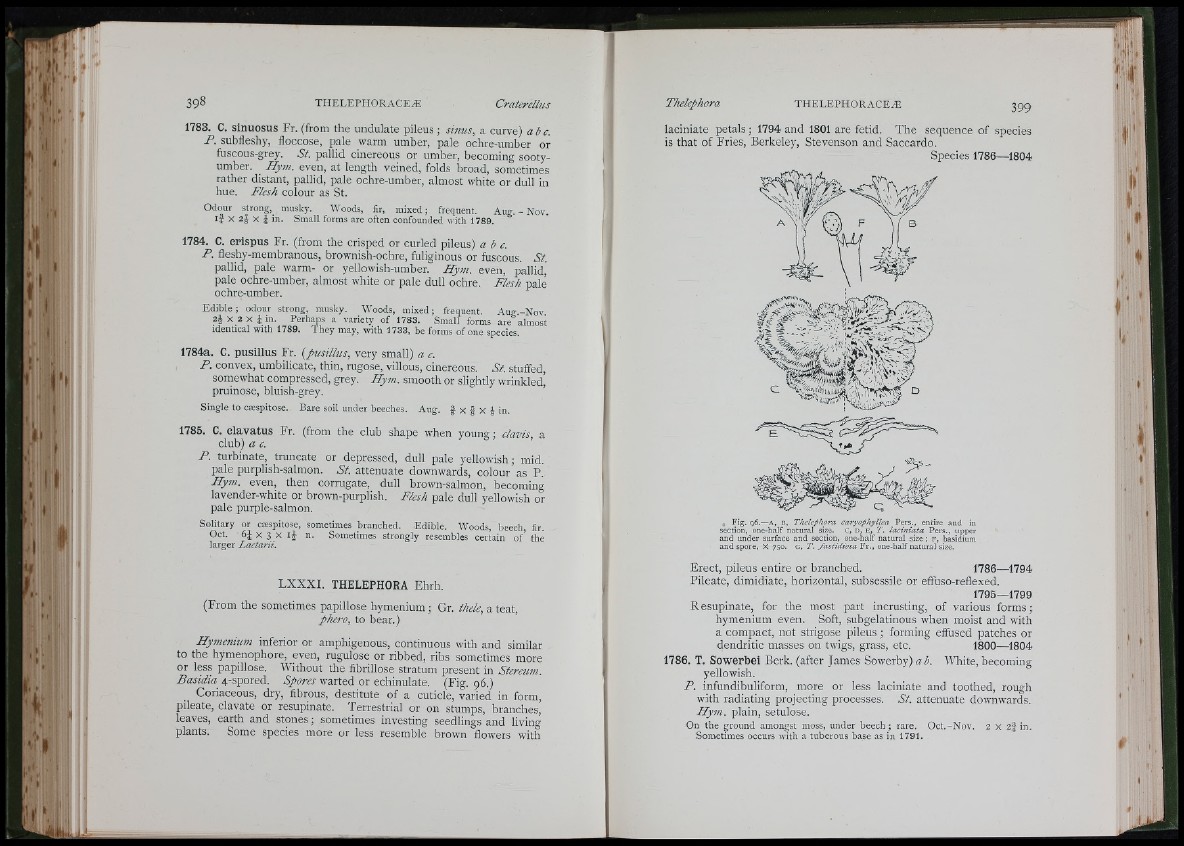
1783. C. sinuosus Fr. (from the undulate pileus; sinus, a curve) abc.
P. subfleshy, floccose, pale warm umber, pale ochre-umber or
fuscous-grey. St. pallid cinereous or umber, becoming sooty-
umber. Hym. even, at length veined, folds broad, sometimes
rather distant, pallid, pale ochre-umber, almost white or dull in
hue. Flesh colour as St.
Odour strong,^ musky. Woods, fir, mixed; frequent. A u g .-N o v .
i f X 2® X J in. Small forms are often confounded with 1789.
1784. C. erispus Fr. (from the crisped or curled pileus) abc.
P. fleshy-membranous, brownish-ochre, fuliginous or fuscous. St.
pallid, pale warm- or yellowish-umber. Hym. even, pallid,
pale ochre-umber, almost white or pale dull ochre. Flesh palé
ochre-umber.
Edible ; odonr strong, musky. Woods, mixed ; frequent. Aug -Nov
2j X 2 Xj in. Perhaps a variety of 1783. Small forms are almost
identical with 1789. They may, with 1733, be forms of one species.
1784a. C. pusillus Fr. [pusillus, very small) a c.
P. convex, umbilicate, thin, rugose, villous, cinereous. St. stuffed,
somewhat compressed, grey. Hym. smooth or slightly wrinkled!
pruinose, bluish-grey. ’
Single to cæspitose. Bare soil under beeches. Aug. f X | X J in.
1785. C. elavatus Fr. (from the club shape when young ; clavis, a
club) a c.
P. turbinate, truncate or depressed, dull pale yellowish; mid.
pale purplish-salmon. St. attenuate downwards, colour as P.
Hym. even, then corrugate, dull brown-salmon, becoming
lavender-white or brown-purplish. Flesh pale dull yellowish or
pale purple-salmon.
Solitary or cæspitose, sometimes branched. Edible. Woods, beech, fir.
Oct. 6® X 3 X I® n. Sometimes strongly resembles certain of’ thé
larger Lactarii.
LXXXI. THELEPHORA Ehrh.
(From the sometimes papillose hymenium; Gr. a teat,
phero, to bear.)
Hymenium inferior or amphigenous, continuous with and similar
to the hymenophore, even, rugulose or ribbed, ribs sometimes more
or less papillose. Without the fibrillose stratum present in Stereum.
Basidia 4-spored. Spores warted or echinulate. (Fig. 96.)
Coriaceous, dry, fibrous, destitute of a cuticle, varied in form,
pileate, clavate or resupinate. Terrestrial or on stumps, branches,
leaves, earth and stones; sometimes investing seedlings and living
plants. Some species more or less resemble brown flowers with
laciniate petals ; 1794 and 1801 are fetid. The sequence of species
is that of Fries, Berkeley, Stevenson and Saccardo.S
pecies 1786—1804
. Fig. q6.—A, B, Thelephora caryophyllea Pers., entire and in
section, one-half n atu ral size, c, d , e , T . la cin ia ta Pers., upper
and under surface and section, one-half n atu ral size ; f , basidium
and spore, X 750. g , T. fa s tid io sa F r ., one-half n atural size.
Erect, pileus entire or branched. 1786—1794
Pileate, dimidiate, horizontal, subsessile or effuso-reflexed.
1795—1799
Resupinate, for the most part incrusting, of various forms;
hymenium even. Soft, subgelatinous when moist and with
a compact, not strigose pileus ; forming effused patches or
dendritic masses on twigs, grass, etc. 1800—1804
1786. T. Sowerhei Berk, (after James Sowerby) a b. White, becoming
yellowish.
P. infundibuliform, more or less laciniate and toothed, rough
with radiating projecting processes. St. attenuate downwards.
Hym. plain, setulose.
On the ground amongst moss, under beech; rare. Oct.-Nov. 2 X 2f in.
Sometimes occurs with a tuberous base as in 1791.
' I